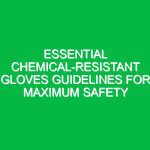Essential Chemical Safety Guidelines: Avoid These Critical Risks!
In any workplace that handles chemicals, understanding and implementing Safety guidelines is vital for protecting employees’ health and preventing accidents. Chemicals can pose significant risks if not managed properly, leading to injuries, health issues, and even fatalities. This Toolbox Talk will delve into essential Chemical Safety guidelines and highlight critical risks that every employee should be aware of to ensure a safe working Environment.
Understanding Common Chemical Hazards
Types of Chemical Hazards
Chemical hazards can be classified into various categories, including flammable, corrosive, reactive, and toxic substances. Each type of chemical has unique risks and requires specific handling Procedures. For instance, a corrosive chemical like sulfuric acid can cause severe skin Burns upon contact, while flammable solvents can ignite easily, leading to Fires. Understanding the characteristics of the chemicals you work with is crucial for effective hazard management.
For example, in a manufacturing facility, a worker was tasked with cleaning machinery using a flammable solvent. They neglected to read the Safety Data Sheet (SDS) and used the solvent near an open flame, resulting in a significant fire that caused injuries and damage. This incident underscores the importance of recognizing the types of chemical hazards present in your work environment.
Personal Protective Equipment (PPE)
Choosing the Right PPE
Personal protective equipment (PPE) is a critical line of defense against chemical exposure. Employees must wear appropriate PPE based on the chemicals they handle. This can include gloves, goggles, face shields, lab coats, and respiratory protection, depending on the nature of the work being performed.
For instance, in a warehouse that handles cleaning chemicals, employees were observed without gloves while handling bleach. After a Safety briefing, they learned the importance of wearing chemical-resistant gloves to prevent skin irritation and injuries. Encourage your team to always assess the necessity of PPE before starting any task involving chemicals.
Safe Handling and Storage of Chemicals
Best Practices for Chemical Safety
Proper handling and storage procedures are essential in preventing chemical spills and accidents. Always store chemicals in designated areas, preferably in well-ventilated spaces, and ensure containers are labeled clearly with their contents and hazards. Never store chemicals near heat sources or incompatible substances that could react dangerously.
A case study involved a warehouse where different acids and bases were stored on the same shelf without proper segregation. A spill occurred due to a broken container, leading to a hazardous reaction and necessitating emergency response. This scenario highlights the importance of following correct storage practices and ensuring that all employees are trained in safe handling techniques.
Emergency Response Procedures
Preparedness and Awareness
Despite best efforts, accidents can happen. It is crucial for all employees to be familiar with emergency response procedures in the event of a chemical spill or exposure. This includes knowing how to use safety showers, eye wash stations, and how to report incidents immediately.
For example, in a laboratory setting, a researcher accidentally spilled a hazardous chemical. Because the team had practiced their emergency response plan, they quickly activated the safety shower and notified the safety officer, minimizing exposure and potential harm. Engage your team by asking, “What steps do you think should be taken in the event of a chemical spill?”
Training and Continuous Education
Importance of Ongoing Training
Regular training and education on chemical safety are vital for maintaining a safe workplace. Employees should receive training on recognizing hazards, using PPE, and following proper procedures for handling and disposing of chemicals. Continuous education ensures that employees are aware of the latest safety practices and any changes in Regulations or workplace procedures.
Consider a scenario where a new employee in a manufacturing plant received thorough training on chemical safety. This employee was able to identify a potential hazard while working with a new chemical and took the necessary Precautions to prevent an incident. Encourage your team to share their experiences and thoughts on how further training could help improve safety in your workplace.
Conclusion and Call-to-Action
By adhering to essential chemical safety guidelines, employees can significantly reduce risks and create a safer working environment. Remember to always assess chemical hazards, wear appropriate PPE, follow safe handling and storage practices, and be prepared for emergencies. Engaging in regular training will also reinforce these principles and keep safety at the forefront of daily operations.
Take these lessons to heart, and let’s commit to applying them consistently in our work. Please use this article as a discussion starter in your Toolbox Talks and safety meetings. Together, we can foster a culture of safety that prioritizes the health and well-being of everyone in the workplace.


